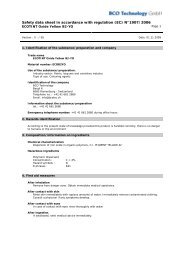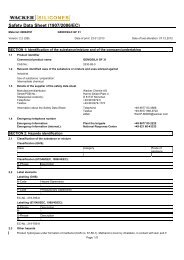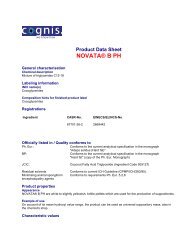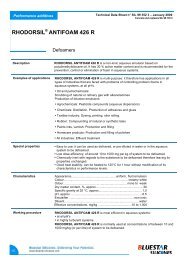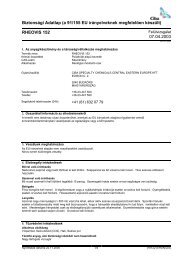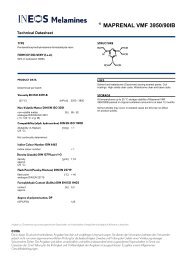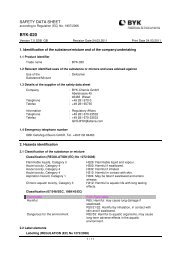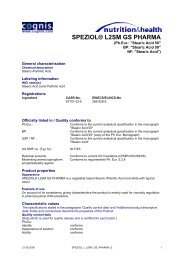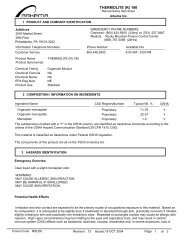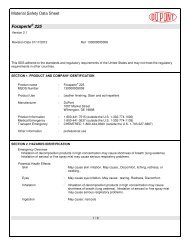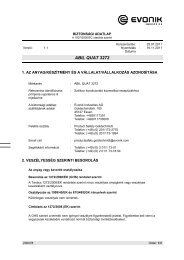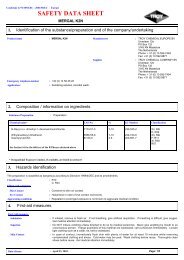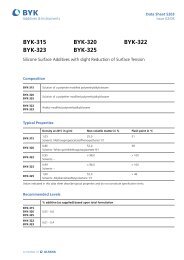VINNOL® H 40/50
VINNOL® H 40/50
VINNOL® H 40/50
- No tags were found...
You also want an ePaper? Increase the reach of your titles
YUMPU automatically turns print PDFs into web optimized ePapers that Google loves.
VINNOL® H <strong>40</strong>/<strong>50</strong>VINYL CHLORIDE COPOLYMER, CAS NO. 9003-22-9Product descriptionVINNOL® H <strong>40</strong>/<strong>50</strong> is a copolymer of approx. 63 wt.%vinyl chloride (VC) and approx. 37 wt.% of vinylacetate (VAc). Its main use is as a binder for surfacecoating compounds and printing inks.PropertiesVINNOL® H <strong>40</strong>/<strong>50</strong> is a thermoplastic, physically dryingbinder that forms a film when the solvent contained inthe formulation has evaporated.Like all VC copolymers, VINNOL® H <strong>40</strong>/<strong>50</strong> isextremely tough, showing permanent flexibility,abrasion resistance, little tendency to swell in thepresence of water and low gas permeability. It is alsohighly resistant to oil, grease, dilute aqueous acids,alkalis and saline solutions, as well as to aliphatichydrocarbons, such as white spirit, and alcohols.Special featuresVINNOL® H <strong>40</strong>/<strong>50</strong> is a high vinyl acetate containingcopolymer. It is therefore especially suitable as acobinder for formulating flexible VINNOL®-paint andprinting ink formulations. It is also highly recommendedto reduce the sealing temperature in VINNOL®-basedheat sealing lacquers.VINNOL® H <strong>40</strong>/<strong>50</strong> also shows a surprisingly goodcompatibility with ester soluble nitrocellulose resinsand can be used for their modification.ApplicationTypical applications for VINNOL® H <strong>40</strong>/<strong>50</strong>:- Heat-sealable lacquers- Printing inks- Paper and film coatings- Wood varnishes- Strippable lacquers- Masonry paints- Road-marking paintsProcessingVINNOL® H <strong>40</strong>/<strong>50</strong> is generally used in dissolved form.Ketones, in particular, are excellent solvents forVINNOL® surface coating resins. In the case ofVINNOL® H <strong>40</strong>/<strong>50</strong>, esters, too, may be used as singlesolvents.Of the chlorinated hydrocarbons, methylene chlorideand 1,2-dichloroethane are true solvents, while tri- andtetrachloroethene have only a swelling effect.Aromatic hydrocarbons have a swelling effect but maybe combined to a limited extent with true solvents up to<strong>50</strong>%. Alcohols and aliphatic hydrocarbons do notdissolve VINNOL® H <strong>40</strong>/<strong>50</strong>.VINNOL® H <strong>40</strong>/<strong>50</strong> can be plasticized with monomericand polymeric plasticizers, such as phthalates,adipates, sebacates, citrates, phosphates, epoxidesand chlorinated paraffins.VINNOL® H <strong>40</strong>/<strong>50</strong> is fully compatible with all otherVINNOL® surface coating resins. It also combines wellwith many acrylic polymers and ketone resins, estersoluble nitrocellulose as well as with some epoxides.Alkyd resins, polyvinyl acetates and polyvinyl butyralsare in general incompatible with VINNOL® H <strong>40</strong>/<strong>50</strong>.We recommend always checking the compatibility ofVINNOL® H <strong>40</strong>/<strong>50</strong> with the polymer in question.VINNOL® H <strong>40</strong>/<strong>50</strong> shows good compatibility withpigments routinely used in the coatings industry.Care must be taken when using pigments containingzinc or cadmium because these catalyze thedecomposition of VC copolymers at elevatedtemperatures. The same applies to iron-oxidepigments.Despite good inherent stability, it is necessary forsome applications to stabilize coatings based onVINNOL® H <strong>40</strong>/<strong>50</strong> against heat and/or UV light. Epoxycompounds often suffice to stabilize these coatingsagainst low thermal impact. Where highertemperatures are involved, it is advisable to usecalcium/zinc or organotin stabilizers.Outdoor applications require the additional use of UVstabilizers along with thermal stabilizers optimized forthese conditions.To avoid risk of discoloration, contact with iron shouldbe avoided both during preparation of the solution andduring subsequent storage of the product. VINNOL®basedsurface-coating resins should be stored incoated containers.Technical data sheet for VINNOL® H <strong>40</strong>/<strong>50</strong> / Version: 1.2 / Date of last alteration: 30.05.2012 1 / 3
StorageStore VINNOL® H <strong>40</strong>/<strong>50</strong> under dry conditions and atroom temperature (below 25 °C). Under theseconditions, the product has a shelf life of at least 12months, from the delivery date. If the material is keptbeyond the recommended shelf life, it is notnecessarily unusable, but the user should perform aquality control on the properties relevant to theapplication. The properties determined in our prereleasequality control may change during storage,depending on storage conditions, and deviate from thespecification.PackagingVINNOL® H <strong>40</strong>/<strong>50</strong> is packed in 25-kg, coated three-plypaper bags containing a polyethylene liner.The monomers used in the production of VINNOL® H<strong>40</strong>/<strong>50</strong> are listed in section 1 of the EU ResolutionAP(2004)1 as well as in section A of CommissionDirective 2002/72/EC.VINNOL® H <strong>40</strong>/<strong>50</strong> is suitable for use under FDA 21CFR § 175.105 and §175.300.If VINNOL® H <strong>40</strong>/<strong>50</strong> is used in applications other thanthose mentioned, the choice, processing and use ofVINNOL® H <strong>40</strong>/<strong>50</strong> is the sole responsibility of thepurchaser. All legal and other regulations must becomplied with.Safety notesComprehensive instructions are given in thecorresponding Material Safety Data Sheets. They areavailable on request from WACKER subsidiaries ormay be printed via WACKER web sitehttp://www.wacker.com.Additional informationProduct dataSpecification data Inspection Method ValueChlorine content specific method 35,1 - 36,3 wt. %K-value DIN EN ISO 1628-2 49 - 51Volatiles specific method < 2,0 wt. %Viscosity 1) (20% solids in MEK) DIN 53015 (20°C) 45 - 65 mPa*sTypical general characteristics Inspection Method ValueEfflux time (20% in MEK) DIN EN ISO 2431 approx. 45 s(4 mm)Supply form Visual white powderParticle size specific method < 1,0 mmBulk density DIN EN ISO 60 approx. 7<strong>50</strong> kg/m³Density DIN 66137-2 1,31 g/cm³Glass transition temperature DSC (DIN 53765 / approx. 60 °CISO 11357-5)Molecular weight (M W ) SEC, PS-Standard 60000 - 800001) after dissolving at <strong>50</strong>°CThese figures are only intended as a guide and should not be used in preparing specifications.Technical data sheet for VINNOL® H <strong>40</strong>/<strong>50</strong> / Version: 1.2 / Date of last alteration: 30.05.2012 2 / 3
The data presented in this leaflet are in accordance with the present state ofour knowledge, but do not absolve the user from carefully checking allsupplies immediately on receipt. We reserve the right to alter productconstants within the scope of technical progress or new developments. Therecommendations made in this leaflet should be checked by preliminarytrials because of conditions during processing over which we have nocontrol, especially where other companies' raw materials are also beingused. The recommendations do not absolve the user from the obligation ofinvestigating the possibility of infringement of third parties' rights and, ifnecessary, clarifying the position. Recommendations for use do notconstitute a warranty, either express or implied, of the fitness or suitability ofthe products for a particular purpose.The management system has beencertified according to DIN EN ISO9001 and DIN EN ISO 1<strong>40</strong>01WACKER is a trademark of WackerChemie AG.VINNOL® is a trademark of WackerChemie AG.For technical, quality, or productsafety questions, please contact:Wacker Chemie AGHanns-Seidel-Platz 481737 München, Germanyinfo.polymers@wacker.comwww.wacker.comTechnical data sheet for VINNOL® H <strong>40</strong>/<strong>50</strong> / Version: 1.2 / Date of last alteration: 30.05.2012 3 / 3



